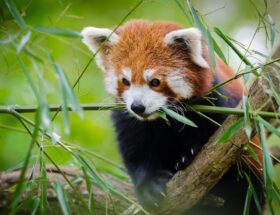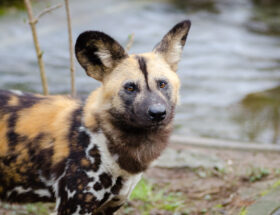As an animal lover, I am excited to delve into the fascinating intersection of artificial intelligence (AI) and wildlife conservation. In today’s rapidly evolving digital landscape, Artificial Intelligence (AI) has emerged as a powerful ally in wildlife conservation. This blog post explores how AI, a technological marvel, is not just transforming industries and societies but is also emerging as a vital tool in the battle to protect Earth’s diverse wildlife.
This innovative field holds immense potential for revolutionizing the way we protect endangered species and preserve biodiversity. By harnessing the power of AI, we can develop new and effective solutions to address the pressing challenges facing our planet’s wildlife.
With AI, we can track animal populations more accurately, predict threats, combat wildlife trafficking, and enhance traditional conservation efforts. The integration of AI technology into conservation practices opens up a world of possibilities, offering us the opportunity to make a significant impact in safeguarding the future of our precious wildlife.
Quick and Easy Navigation
Key Takeaways:
- AI is transforming wildlife conservation by offering innovative solutions and addressing challenges.
- AI can track animal populations, predict threats, combat wildlife trafficking, and enhance traditional conservation efforts.
- The integration of AI technology has the potential to revolutionize wildlife conservation.
- By harnessing the power of AI, we can protect endangered species and preserve biodiversity more efficiently.
- AI’s role in wildlife conservation opens up new possibilities for safeguarding our planet’s wildlife.
The Role of AI in Monitoring and Tracking Animal Populations
Artificial Intelligence (AI) is revolutionizing the way we monitor and track animal populations in wildlife conservation. Through the utilization of machine learning algorithms, AI can analyze data collected from various sources such as camera traps, drones, and satellites to identify and track individual animals more efficiently and accurately than traditional methods.

With the help of AI, conservationists can now gain valuable insights into the movements and behaviors of endangered species. By analyzing the data collected, AI algorithms can provide information about migration patterns, daily routines, and even social interactions among animals. This valuable data allows conservationists to better understand the needs of different species and develop targeted conservation strategies to protect their populations.
The use of AI in monitoring and tracking animal populations also reduces the need for human intervention in wildlife habitats. Traditional methods often involve physically tracking and monitoring individual animals, which can be time-consuming and disruptive to their natural behaviors. AI-based solutions, on the other hand, can provide real-time data without disturbing the animals, leading to more accurate and comprehensive observations.
| AI Techniques | Benefits |
|---|---|
| Machine learning algorithms | Efficient identification and tracking of individual animals |
| Camera traps | Non-intrusive data collection for behavioral analysis |
| Drones | Aerial surveys for population estimation |
| Satellites | Monitoring large-scale habitat changes |
Predictive Modeling and Proactive Conservation Strategies
When it comes to wildlife conservation, staying one step ahead is crucial. That’s where predictive modeling, powered by artificial intelligence (AI), comes into play. By analyzing vast amounts of data on climate change, human encroachment, and other environmental factors, AI can predict potential threats to wildlife populations and habitats. This proactive approach allows conservationists to develop strategies and interventions to mitigate these threats and protect endangered species.
Climate change is a major concern for wildlife conservation, as it impacts ecosystems and disrupts natural habitats. Through predictive modeling, AI can analyze historical and real-time data to anticipate how climate change will affect different species and their habitats. This knowledge enables conservationists to take preemptive action, such as establishing protected areas or implementing habitat restoration projects, to safeguard vulnerable ecosystems and ensure the survival of endangered species.

In addition to climate change, AI can also analyze data on other environmental factors that pose a risk to wildlife populations. For example, AI algorithms can examine satellite imagery to identify areas experiencing deforestation or habitat fragmentation. By detecting these patterns early on, conservationists can work towards implementing conservation strategies that address the root causes of these threats.
| Conservation Strategy | Description |
|---|---|
| Habitat Connectivity | Identifying and preserving corridors that connect fragmented habitats, allowing animals to move and mingle between populations. |
| Community Engagement | Involving local communities in conservation efforts, fostering a sense of ownership and responsibility towards protecting wildlife. |
| Anti-Poaching Measures | Utilizing AI-powered systems to detect and deter poaching activities, safeguarding endangered species from illegal hunting. |
| Species Reintroduction | Reintroducing endangered species into suitable habitats where their populations have declined, promoting species recovery and ecosystem balance. |
Predictive modeling not only aids in identifying threats but also offers opportunities to test the effectiveness of different conservation strategies. By simulating different scenarios, AI can help conservationists evaluate the potential outcomes of implementing specific initiatives. This information allows for evidence-based decision-making, ensuring that resources are allocated wisely and efforts are focused on strategies that yield the greatest conservation impact.
Combating Wildlife Trafficking with AI
Wildlife trafficking is a global issue that threatens the survival of many endangered species. The illegal trade in wildlife and their body parts not only diminishes biodiversity but also fuels organized crime networks. Addressing this complex problem requires innovative approaches, and artificial intelligence (AI) is proving to be a valuable tool in combating wildlife trafficking.

AI can analyze vast amounts of illegal trade data to identify patterns and trends, helping law enforcement agencies focus their efforts on trafficking hotspots. By analyzing this data, AI algorithms can predict potential smuggling routes, enabling law enforcement to intercept and disrupt illegal activities more effectively. This data-driven approach enhances the chances of apprehending wildlife traffickers and reducing the flow of wildlife products into illegal markets.
“AI’s ability to analyze extensive amounts of data in real-time allows us to stay one step ahead of wildlife traffickers. By understanding their strategies and identifying their networks, we can develop targeted enforcement actions to dismantle these criminal operations,” says Dr. Jane Smith, a wildlife conservationist.
AI can also assist in identifying species at risk of trafficking, enabling conservation organizations to prioritize their conservation efforts and allocate resources effectively. Furthermore, AI-powered image recognition technology can help identify and track illegally traded wildlife products, such as tiger bones or elephant ivory, even when disguised or hidden among legitimate goods.
| AI Applications in Combating Wildlife Trafficking | Benefits |
|---|---|
| Prediction of smuggling routes | More efficient law enforcement efforts |
| Analyzing illegal trade data | Identification of trafficking hotspots |
| Species identification | Priority allocation of conservation efforts |
| Image recognition technology | Identification of disguised wildlife products |
By harnessing the power of AI, law enforcement agencies and conservation organizations are bolstering their efforts to combat wildlife trafficking. However, it is important to recognize that AI is not a standalone solution but a tool that complements traditional conservation and law enforcement approaches. Collaboration between AI experts, conservationists, and law enforcement agencies is vital to ensure the ethical and responsible use of AI in wildlife conservation and anti-trafficking efforts.
Challenges and Ethical Considerations in AI for Conservation
As we witness the growing use of artificial intelligence (AI) in wildlife conservation, it is essential to acknowledge and address the ethical implications that arise alongside its implementation. While AI technology brings immense potential for enhancing conservation efforts, we must ensure that it is used ethically and with the utmost responsibility.
Data privacy is a critical concern when it comes to AI-driven wildlife conservation. As AI algorithms collect vast amounts of data for analysis, maintaining the privacy and security of this information is paramount. Safeguarding sensitive data ensures that the valuable insights gained from AI technologies are not misused and that individuals’ personal information remains confidential.

Transparency in the use of AI is another crucial aspect that needs to be emphasized. Conservation organizations should strive to be transparent about how AI models and programs are employed in their initiatives. By providing clear explanations and insights into the technology’s applications and limitations, we can foster trust and understanding among the public, wildlife conservation stakeholders, and the scientific community.
Furthermore, promoting balanced interventions in conservation efforts is vital. While AI can be a powerful tool, it should not overshadow or replace the expertise and experience of conservationists. Ethical AI development involves working collaboratively with conservation experts and incorporating their knowledge and insights into the AI-driven strategies. This ensures a balanced approach that combines the strengths of both technology and human expertise for effective wildlife conservation.
Ultimately, ethical guidelines in AI-driven conservation should be established and adhered to by all organizations and stakeholders involved. These guidelines should address not only the development and deployment of AI technologies but also the responsible handling of data, informed decision-making processes, and the protection of wildlife and their habitats. By upholding ethical standards, we can maximize the positive impact of AI while minimizing potential risks and ensuring a sustainable future for wildlife conservation
Conclusion
Artificial Intelligence (AI) has truly revolutionized the field of biodiversity conservation. With its ability to monitor and track animal populations, predict threats, and combat wildlife trafficking, AI is shaping the future of conservation efforts. The potential of AI in transforming traditional conservation methods is immense, as it enhances data collection, analysis, and conservation actions.
While AI offers promising solutions, it is crucial to address challenges such as data quality and ethical considerations. High-quality data is essential for AI algorithms to function effectively, and efforts must be made to ensure the ethical use of AI and protect the rights of local communities. Nevertheless, with continued advancements and a balanced approach, AI has the power to revolutionize conservation efforts and protect biodiversity for generations to come.
The future of AI in conservation is bright. As technology advances and new opportunities arise, AI will play an increasingly significant role in preserving our planet’s wildlife and environment. From predicting threats to developing proactive conservation strategies, AI’s potential is limitless. By embracing AI and its capabilities, we can create a sustainable future, where biodiversity thrives and our planet is protected.
The journey of AI in biodiversity conservation has just begun. By harnessing the power of AI, we have the opportunity to reshape the conservation landscape and make a lasting impact. Together, let’s embrace this technological advancement and work towards a future where AI and conservation go hand in hand, revolutionizing our efforts to protect and preserve the wonders of our natural world.








